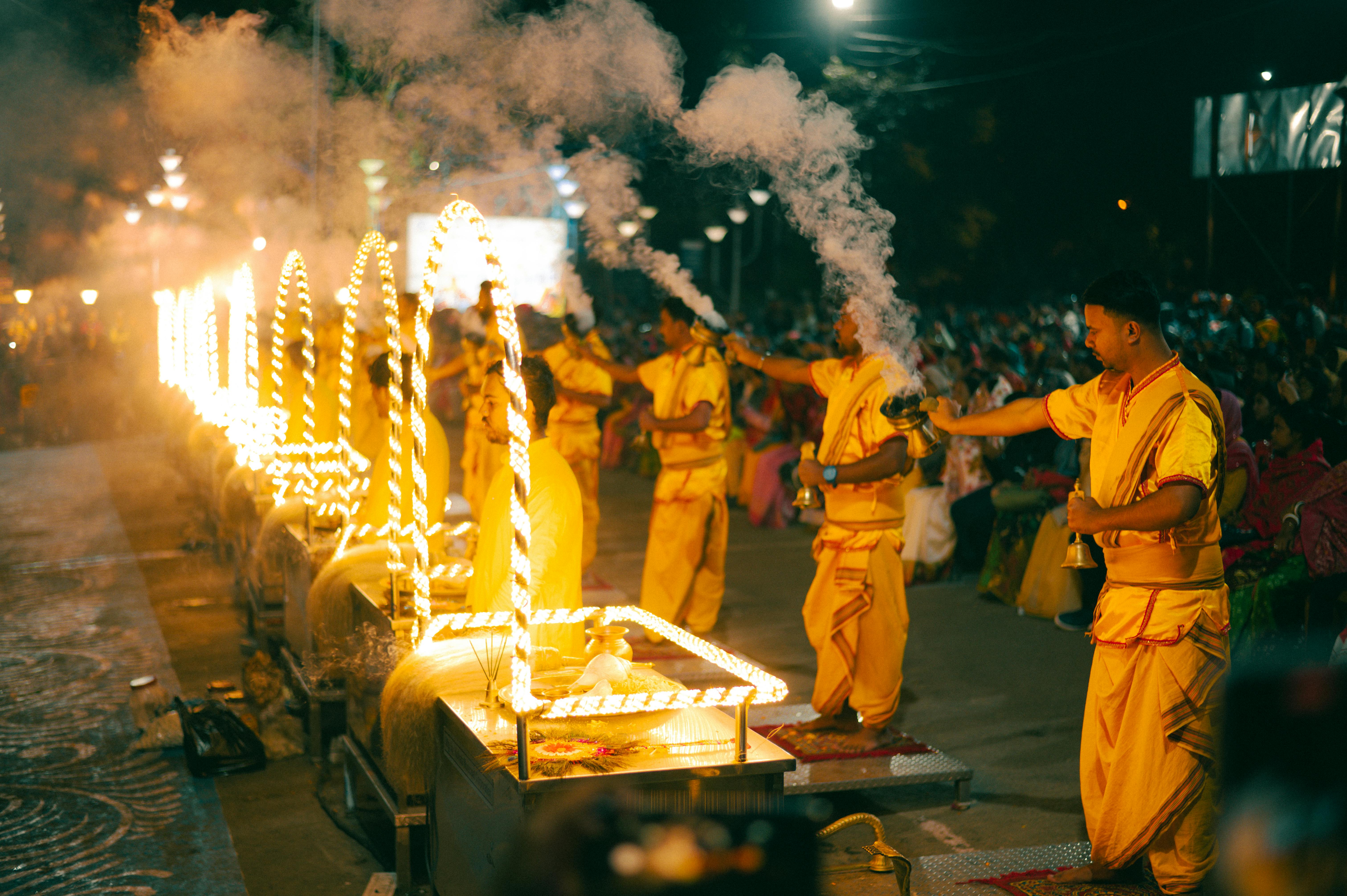Buddhist Pilgrimage Tour

Detailed Itinerary
Day 1Arrival Delhi
Arrive by International flight, after traditional Indian style ‘Swagat’ (Welcome) by Exceptional Escapes representative, he would assist you at the airport & transfer to hotel for check in.
Delhi takes pride in being the capital of the country for many dynasties. It is in fact a city wrapped in legend, where time flows differently, and where every moment becomes a moment of history. A vibrant melting pot, it encapsulates two very different worlds, the 'old' and the 'new', each representing delectably different experiences. Come experience it...
Rest of the time for relax.
Overnight Hotel – Delhi
Day 2DELHI- VARANASI (AIR INDIA AI-406@1015 / 1135 HRS)
Post breakfast transfer to airport to board flight to Varanasi, on arrival Exceptional Escapes representative would assist you at the Airport and transfer to hotel for check in.
Varanasi; picturesquely situated on the banks of holy river Ganga. The city is the Oldest Living City of the World & traces of its existence are found around 10000 BC. Other than being a very holy city for Hindus, it also holds a very significant association with Buddha's life & Buddhism.
Later a Guided Excursion to Sarnath
Later proceed for guided excursion to Sarnath; the site of the deer park where Gautama Buddha is said to have given his first sermon about the basic principles of Buddhism. It has been a premier centre for Buddhism & has a rich collection of ancient Buddhist relics & antiques comprising numerous Buddha & Bodhisattva images on display at the Archaeological Museum (Closed on Fridays)
Dhamekh Stupa; an imposing 33 m high cylindrical Stupa & the most impressive sight in Sarnath, built around the year 500 AD. It is suggested that this Stupa has close association with the Buddha’s Dhamma (the teachings of Buddha which lead to enlightenment).
Dharmarajika Stupa, built by Emperor Ashoka is now in ruins & consists of a circular base. It was believed to be built by Ashoka to enshrine the bodily relics of Lord Buddha at the time of his re-distributing the relics from the seven original Stupas & enshrining them in a number of other Stupas at different places.
Ashoka Pillar, reduced to just 2 m high, stands in ruins but the original Pillar was 15 m high & crowned with the magnificent Lion Capital that can be seen in Sarnath Museum. This Pillar is believed to mark the site where Buddha assembled the Sangha (ordained Buddhist monks or nuns) comprising 60 Arahants (highly spiritually evolved Buddhist) & exhorted them to go in different directions to spread the Teaching. On the pillar is an inscription, which says, “Let no one cause a division in the Sangha”.
In the evening we take you for Evening Aarti at Dasaswamedh Ghat. (Not to Miss activities, highly recommended)
Overnight Hotel – Varanasi (B)
Day 3VARANASI - BODHGAYA (245 KMS – 4-5 HRS)
Start your DAY with a private boat ride on the river Ganges. Rise before dawn & step gingerly in the boat as the boatman starts rowing the boat. Witness the daily miracle to unfold, as the Sun appears triumphantly over the horizon. The sound of conches & temple bells add to the delicate pink fabric of dawn. The formerly hushed murmuring of ancient Sanskrit Shlokas (hymns) now rise, in one voice, to a crescendo of unparalleled piety & joy. Later we explore the city by foot to get the feel of this oldest living city of the world
Later drive to Bodhgaya, the place of Buddha’s Supreme Enlightenment, the most hallowed place on earth to Buddhists. During the Buddha’s time, this place by the banks of the river Niranjana was known as Uruvela. Emperor Ashoka was the first to build a temple at this sacred spot & since his first visit in the year 259 BC, countless pilgrims have visited this cradle of Buddhism without intermission for more than 2500 years. For Buddhists, Bodhgaya is the most important of the four pilgrimage sites related to the life of Lord Buddha.
Rest of the DAY FREE for relax.
Overnight Hotel – Bodhgaya (B,D)
Day 4BODHGAYA
Post breakfast visit the Mahabodhi Temple, undoubtedly the most exquisite-looking building in Bodhgaya. Standing 52 m high, it consists of a straight pyramidal tower surmounted by a stupa. Its roots go back to 3rd century BC when Emperor Ashoka built the shrine there. In subsequent centuries, renovation & further construction took place & the entire Mahabodhi Temple, as seen today, is mainly the structure of the Huviska period (111-138 AD). As it was built over the remains of Ashoka’s Shrine, the Vajrasana Throne retains its original position as the Seat of Enlightenment. Mahabodhi Temple is a UNESCO World Heritage Site.
The Bodhi Tree under which Lord Buddha sat & attained Supreme Enlightenment is situated behind the Mahabodhi Temple. It is a Peepal tree (Ficus religiosa) said to have sprung up at the same time when the Buddha was born. It has a long history of destruction & re-plantation & the present tree originates from sapling of the original tree from Sri Lanka. It is suggested to spend some time in the tranquil atmosphere of this sacred spot & reflect upon the virtues of Lord Buddha, attain fullness of faith & calm, followed by meditation.
Evening at leisure to explore the BODHGAYA City.
Overnight Hotel – Bodhgaya (B,D)
Day 5BODHGAYA - PATNA VIA RAJGIR & NALANDA (205 KMS - 7 HRS)
Post breakfast drive to Patna & en route first visit Rajgir, an ancient town, once the capital of the powerful state of Magadha, & closely associated with the life of Lord Buddha. The most important event of Buddha's visit to Rajgir was the conversion of two future disciples, Sariputra & Maudgalyayana. Following their conversion, many wandering ascetics also became followers of the Buddha. He also converted the Mauryan King Bimbisara, one of his most celebrated followers, at the Griddhakuta Hill, where he delivered many of his Sermons as well. Thus Rajgir became an important centre of Buddhism as the fame of the Buddha spread throughout Magadha. It was also the scene of many attempts by Devadatta, Buddha’s cousin, to kill him over his ideological differences with Buddha. Rajgir is also an important place of pilgrimage for Hindus & Jains.
Shanti Stupa (Stupa of Peace) on top of the Ratnagiri hill built by Japanese, linked by a rope way. Teachings of Buddha were penned down for the first time here.
Veluvana Vihar (Bamboo Grove) was the Royal Park of King Bimbisara, which was donated to Lord Buddha to reside. It is still a pleasant park, planted with shade trees, bamboo & flowers, reflecting its original status as the Royal Park. In the vicinity of Veluvana is a large pond with a Buddha image at the centre.
Post Lunch visit the Karanda Tank mentioned in Buddhist text as the Karanda kanivapa where the Buddha used to take his bath.
Nalanda (insatiable in giving), founded in the 3rd century BC. It was visited several times by Lord Buddha, & the monasteries date from the time of Emperor Ashoka. This greatest seat of learning flourished until 12th century & played a central role in development of Buddhism in India. Ruins of Great Ancient University have been excavated where once 2000 teachers & 10,000 students walked its portals. The ruins extend over a large area, consisting of sites of monasteries, Stupas & temples. In the museum nearby are deposited numerous sculptures & other antiquities recovered during excavations.
Overnight Hotel – Patna (B,D)
Day 6PATNA- KUSHINAGAR VIA VAISHALI (285KM - 8 HR)
Post breakfast drive to Kushinagar, en-route visit Vaishali;
Abhishek Pushkarini, the coronation tank. The sacred waters of the tank anointed the elected representatives of Vaishali.
Japanese temple & the Vishwa Shanti Stupa (World Peace Pagoda). Near the coronation tank is Stupa1 or the Relic Stupa are the Lichchavis reverentially encased on of the eight portions of the Master's relics, which they received after the Mahaparnirvana.
Continuing drive to Kushinagar and visit the Site Museum, it has an excellent collection of terracotta artifacts dating from 3rd century BC to 6th century AD.
Post lunch continue drive to Kushinagar, ancient times, it was known as Kushavati. It was here that Lord Buddha is said to have attained 'Mahaparnirvana', the freedom from the endless cycle of birth & rebirth. Many of the ruined Stupas & viharas here date back to 3rd century BCE 5th century CE when prosperity was at its peak.
Evening FREE.
Overnight Hotel – Kushinagar (B,D)
Day 7KUSHINAGAR- LUMBINI (165 KM- 4 HR)
Post breakfast visit the Nirvana Stupa, it bore an inscription in ancient Brahmi, which stated that Lord Buddha's remains had been deposited here.
Nirvana temple; which houses over 6 meters long statue of reclining Buddha. The statue represents the dying Buddha reclining on his right side. An inscription below dates the statue to the 5th century AD.
Madhukar Shrine, a black stone image of the Buddha in the Bhumi sparsha mudra (touching the earth posture) was recovered here also the last sermon by Lord Buddha was given here.
Ramabhar Stupa, where the Lord Buddha was cremated.
Post lunch drive to Lumbini (Nepal), a Buddhist pilgrimage site located near India Nepal border. It is the birth place of Gautama Buddha, the founder of Buddhism, who lived between approximately 563 BCE & 483 BCE. Lumbini is located 25kms east of the Kapilavastu, the place where the Buddha grew up & lived up to the age of 29. Many auspicious signs accompanied the Buddha's birth, including the sprouting of Bodhi tree. It is an UNESCO World Heritage Site specifically nominated for the international World heritage program.
Overnight Hotel – Lumbini (B,D)
Day 8LUMBINI- SRAVASTI (205 KM- 6 HR)
Post breakfast visit Ashoka Pillar, the first epigraphic evidence relating to the life history of Buddha. The historic importance of the pillar is evidenced by the inscription engraved in the pillar (Brahmi script). It is said that the great Indian Emperor Ashoka visited the site in the 20th year of is ascendancy to the throne & as homage to the birthplace, erected the pillar.
Pushkarni (Sacred Pool), sacred pool in which Maya Devi, mother took a holy dip just before giving birth to the Buddha & also where infant Buddha was also given his first bath.
Sanctum Sanctorum is a stone slab foundation pointing the exact spot of Buddha’s birth. The
Buddhist temple, built inside the complex of Lumbini. The prayer hall contains a large image of Buddha. Medieval style murals decorate the walls.
Post lunch drive to Sravasti, is intimately associated with the life of Buddha. In Buddhist times (6th century BC-6th century AD), was important both as prosperous trading centre & religious. Buddha is believed to have spent 24 monsoons in the city. It is said that Buddha sat on a Lotus with a thousand petals & multiplied his image a million times. A divine sight that silenced his critics
Rest of the day at leisure.
Overnight Hotel – Sravasti (B,D)
Day 9SRAVASTI- LUCKNOW (180 KMS - 5 HRS)
Post breakfast visits the ruins of Jetavana's monastery; Jetavana is said to once host Lord Buddha & his pilgrims, where one of his followers, a rich merchant, covered the whole ground of the park (Vana) with gold coins. Lord Buddha used these coins to build a Vihara here. While there are stories that Jet Vana once housed a giant seven storied building, some others believe that the first statue of Lord Buddha was built here. Next we visit the Sri Lankan monastery.
Post lunch driven to Lucknow, in medieval history begins with its elevation to a capital city under the Nawabs of Awadh. The architectural contributions of the Awadh rulers, many paintings are evident at numerous mosques & palaces. Walking through the lanes & by-lanes of Chowk & Aminabad one finds its yore. The 'tehzib' or mannerism is still prominent & a topic of great appreciation.
Evening free to experience the culture of Awadh Rulers City.
Overnight Hotel – Lucknow (B)
Day 10LUCKNOW – DELHI {INDIGO 6E 951 @ 16:15 / 17:40 HRS}
Post breakfast visit lucknow city tour visiting
Bara Imambara, built by Asaf-ud-daulah, Nawab of Lucknow in 1784. Bara means big, & the term Imamabad refers to the residence of the Imam, a religious leader in Islam. The complex also includes the large Asfi mosque, bhulbhulayah (labyrinth) & bowli, a summer palace with running water.
The Residency Alambagh, built in 1800 by Sadat Ali for the British Resident. Today it stands desolate as a mute witness to Mutiny of 1857 when it was almost completely destroyed. Despite its numerous scars, this monument retains till today its original charm that almost recreates the history associated with it & is a stark reminder of the numerous sieges during the Mutiny.
Dilkusha Palace was constructed by Sadat Ali Khan as a hunting retreat. The palace is laid down amidst extensive parks near the bank of river Gomti.
In time transfer to airport to board the flight to Delhi, taking back a memory of Lord Gautam Buddha Life….
Tour Concludes: Exceptional Escapes Manager will assist you with your transfer to the airport for boarding onward flight.
Inclusions:
Exclusions:

